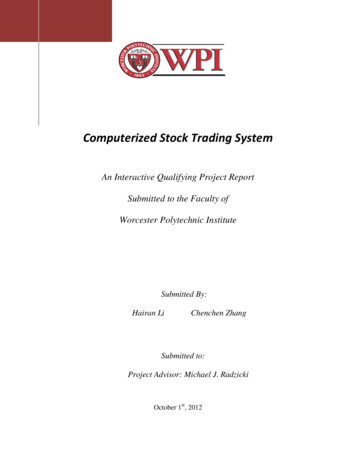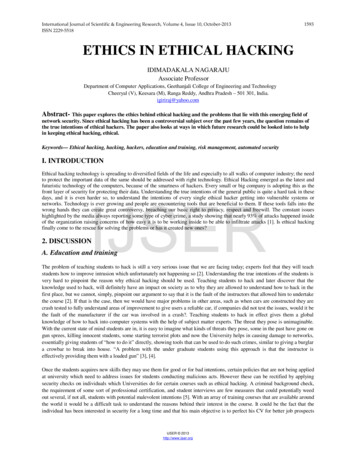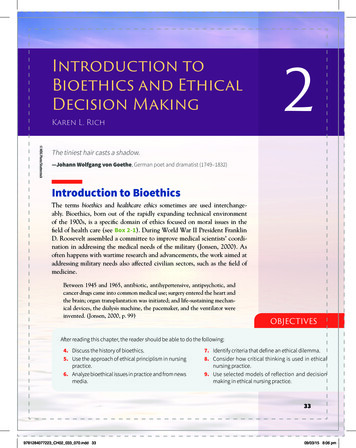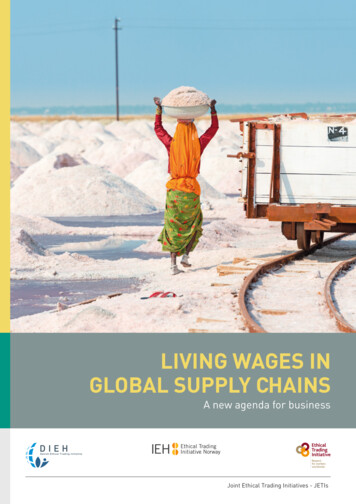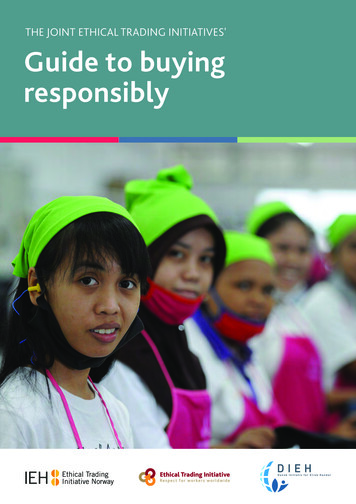
Transcription
THE JOINT ETHICAL TRADING INITIATIVES'Guide to buyingresponsibly
About this guideThis is a guide for organisations seeking to develop and implement responsiblepurchasing practices. It draws on the findings of a major supplier survey conducted bythe Ethical Trading Initiatives of Denmark, Norway and the UK (referenced throughoutas the ETIs) and the International Labour Organization (ILO) in 2016, delivers robustinsights and analysis, and provides comprehensive, practical recommendations for seniormanagers and buyers. The survey was partly funded by the German Federal Ministry forEconomic Cooperation and Development (BMZ).Through the survey, we sought the views of suppliers to UK, Denmark and Norway-basedmember companies across multiple sectors, and of members of SEDEX.i In evaluatingalmost 1,500 suppliers’ responses, we uncovered distinct trends relating to howcustomers’ purchasing practices affect suppliers’ ability to plan production effectively,maintain efficiency and support workers’ rights.Focusing primarily on manufacturing supply chainsii, the guide also shares insights fromthe ETIs, their members, trade unions and specialist NGOs, such as Traidcraft and Oxfam.It builds on the existing purchasing practices guides of ETI Norway and ETI UK, providesa successor to the popular Suppliers Speak Up' guide, and incorporates the Danish ETI'swork on purchasing practices.The ETIs would like to wish you the very best of luck in your journey to more responsiblepurchasing. We are here to support you at every stage of the journey. For more information,ideas, support and resources please contact: Dansk Initiativ for Etisk Handel (DIEH) (Danish Ethical Trading Initiative) – info@dieh.dk Ethical Trading Initiative – eti@eti.org.uk Initiativ for Etisk Handel (IEH) (Ethical Trading Initiative Norway) – info@etiskhandel.noWriter: Katharine EarlyEditors: Katrine Karlsen, IEH; Pi Bjerregard, DIEH and Sabita Banerji, ETIPhotos: ILO, Better WorkDesign: Maia Berghisedexglobal.com is a collaborative platform for sharing responsible sourcing data on supply chains, used by more than 40,000 members in over 150 countries.iiFor more information on responsible purchasing in agricultural supply chains, we recommend Traidcraft’s guides to better tea and vegetable growing attraidcraft.co.uk/resourcesearch.
1Message from the Executive Directorsof ETI Denmark, Norway and UKDear buyers and senior managers,Welcome to the ETI’s Guide to Buying Responsibly. We hope it will serve as a useful reference guide andtool for your organisation’s responsible purchasing journey.The link between conventional purchasing practices and the impact on working conditions in productioncountries is not new. What we have done here, together with our partners at the ILO, is to conductin-depth research into this relationship. We have explored the connection between specific purchasingpractices and the knock-on effects for suppliers, and consequently, workers. This is key as purchasingpractices have the potential to undermine the efforts of responsible business and compliance activities.So why now? As we write this guide, nearly two thirds of the world’s poor make a living from agriculture1,while an estimated 60m workers2 (largely women) are employed by the garment industry alone. Whilenot all of these form part of global supply chains they form the context for conditions for many. Yetconsumers are offered ever lower prices and expect high availability which drives buyers to adopt practicesthat have unintended consequences. A better understanding of how purchasing practices impact workersensures that companies keep the commitments that they make to their consumers, ensure responsiblebusiness objectives are met and help people escape the cycle of poverty, poor working conditions and lowpay. As acknowledged in the 2015 joint ETI report on Living Wages in Global Supply Chains, A New Agendafor Business, paying living wages is one of the most difficult standards for our members to reach. But weare confident that buying responsibly will help move you and your suppliers closer to this goal, beginningwith the very first step of paying the relevant legal minimum wage.There is growing evidence that taking a responsible stance on purchasing has long-term business benefits.Reports suggest that this approach will allow you to optimise costs, increase productivity and quality, andreduce operational and financial risk. Importantly, enabling suppliers to raise their ethical standards willhelp stabilise your suppliers’ workforce and build resilience in your supply chain, thereby meeting yourown ethical commitments. It builds on the existing purchasing practices guides of ETI Norway and ETI UK,including the influential report, Suppliers Speak Up.We invite you to step forward and take action – across the whole procurement cycle, from developingsourcing strategies to assessing the impact of your purchasing practices. Through this guide, we sharepractical ideas and recommendations to support you at every stage. We provide advice on building thebusiness case and give recommendations for senior managers. This is followed by detailed, step-by-stepadvice for you, the buyers, on sourcing strategy, product development, price negotiation, agreeing faircontracts, forecasting and order placement.At the heart of this guidance sits the idea of developing fair, transparent, two-way relationships withsuppliers. Through all your interactions with suppliers, we recommend that you work together to agreemutually beneficial commercial partnerships that include robust plans to improve conditions for workers andthereby underpin sustainable business as well. Furthermore by helping to improve the lives of workers in yoursupply chain, you will be contributing directly to the global, UN-led push for healthier, fairer futures for all.Yours faithfully,Mette BoyePeter McAllisterHeidi FurustølManaging DirectorDanish Ethical Trading InitiativeExecutive DirectorEthical Trading InitiativeManaging DirectorEthical Trading Initiative - Norway1 Source: World Bank ort-finds-400- million-children-living-extreme-poverty2 Source: ILO thing-leather-footwear/lang--ja/index.htm.
2ContentsWho the guide is for and how to use it3Reducing supply chain risk by buying responsibly4Survey findings – getting to the heart of the issue7SECTION 1 : The business case for buying responsibly12The case for change12Developing or updating human rights policies17Reviewing sourcing strategy and policies17SECTION 2 : Guidance for senior managers18Organisational and behavioural change18Roles, accountability and responsibility19Performance management and reward20Understand current purchasing practices21Analyse the impact of purchasing practices22SECTION 3 : Guidance for buyers26Module 1: Sourcing strategy and partnering with suppliers27Module 2: Internal procedures, planning and product development34Module 3: Inviting quotes and negotiating prices38Module 4: Agreeing contractual terms41Module 5: Order placement, production and lead times43Module 6: Assess the impact of purchasing practices46Resources, tools and frameworks48
3Who the guide isfor and how to use itThis reference guide is for senior managers responsiblefor purchasing, individual buyers and their teams and allteams with a connection to procurement. It is intendedas a toolkit of practical ideas and step-by-step actionsfor achieving best practice, supported by the surveyfindings, expert insights and case studies. While itfocuses predominantly on manufacturing supply chains,it also shares many practices that are applicable for allsectors. Overall, we aim to help you strive for a ‘win-win’partnership with suppliers that supports workers’ rights.The first section is designed to help senior managementand purchasing managers develop the business case forchange and lay the foundations for responsible purchasingpractices and sourcing strategies by strengthening sourcingstrategies and human rights policies.In the second section, senior managers and buyers at alllevels will find key information on catalysing the broaderorganisational and behavioural change required, definingroles and responsibilities, understanding the impact ofcurrent practices and incentivising good practice.The third section is aimed primarily at buyers, andis intended as a practical, modular guide to specificpurchasing practices.Finally, we have included a comprehensive list ofrecommended resources and tools available to you.
4Reducing supply chain riskby buying responsiblyIt is through their purchasing practices that businesses can have among the most profoundimpacts on human rights. Conventional purchasing practices, including aggressive pricenegotiation, inaccurate forecasting, late orders, short lead times and last minute changes putsuppliers under intense pressure and lead directly to poor working conditions and low pay forworkers.The United Nations Guiding Principles on Business and Human Rights (UNGPs) highlight theimportance of acting on the findings of human rights impact assessments “across relevantinternal functions and processes”. If purchasers do not consider the potential impact of theirdecisions on suppliers’ ability to comply with labour rights standards, “the enterprise riskscontributing to adverse human rights impact.”Similarly, the Organisation for Economic Co-operation and Development (OECD3)guidance on due diligence for responsible supply chains in the garment and footwear sectorrecommends that businesses “implement control measures to prevent contributing to harmthrough their purchasing practices”.4“Responsible purchasing means purchasing in a way that enables positive change at the supplierlevel, so that every part of the supply chain benefits. It requires a trusting, direct and honestrelationship where both parties are able to negotiate and share risks equally, and a purchaserwho is committed to supporting human rights within the supply base.” 5,6Figure 1 shows the risk relationships between current purchasing practices and their potentialeffect on suppliers, workers, the wider labour market and purchasing organisations.73 nciples4 Source: OECD Due Diligence for Responsible Supply Chains5 Other aspects of supply chain dynamics also have an influence on workers’ pay and labour conditions’.6 ‘Buying Matters’ Consultation: Sourcing fairly from developing countries, Traidcraft.7 Source: ‘Buying Matters’ Consultation: Sourcing fairly from developing countries, Traidcraft
5Figure 1 Impacts of poor purchasing practicesPurchasing practices Power imbalance in buyer and supplierrelationship Poor internal communication Inaccurate product specifications and forecasting Nomination and management of material/input suppliersImpact on suppliers Frequent changes to specifications Lack of ethical criteria in contractual terms Compromised bargaining position andpressure to deliver at any cost Lack of support to meet ethical standards Difficulty to plan and manage production Aggressive price negotiation Increased sampling costs Late order No reward for improvementsLeading to pressure on time and cost Unable to secure a price that covers cost of production Inability to meet deadlines Late deliveries Lack of resources to invest in improvements to meetcustomers’ ethical requirementsImpact on workers Suppressed wagesLeading to pressure on capacity, working hoursand labour costs Poor health and safety measures Irregular working hours and excessive overtime Unrealistic performance targets Lack of breaks Lack of regular or permanent workImpact on labour market Harassment and abuse from management Poor employment conditions Lack of investment in training and equipment High worker turnoverLeading to ETI Base Code breaches and potentialbreaches of labour law, labour standards and thecustomers ethical requirements Unauthorised subcontracting Reduced productivity Unresolved industrial disputes and lack of grievancemechanisms Low wages In-work povertyImpacts on brands and retailers Damage to reputation Risk of disruption to supply Risk of inconsistency in quality of products Risk of being downgraded by ETI and other standards.Leading to loss of consumer confidence, loss of marketshare and possible reduction in share price and profits.Based on Oxfam’s Better Business Better Lives Child labour Forced labourLeading to continued exploitation of vulnerableworkers and weak labour market
6As explained in greater depth in ‘Business case for buyingresponsibly’ (Section 1), responsible purchasing is integralto building supply chain resilience and improving lives. Itcan have a significant impact on workers: nearly two thirdsof the world’s poor make a living from agriculture8 and anestimated 60m workers9 are employed in the global garmentindustry, most of whom are women.The opportunity to sell to international buyers helps to liftpeople out of poverty. However, conventional purchasingpractices can undermine relationships with suppliers andproduce negative consequences for workers. For example,intense competition for customers’ business can pushsuppliers to engage in a ‘race to the bottom’ on price.39% of suppliers responding to oursurvey said they accepted orders belowthe cost of production in 2015, 29% ofwhom then struggled to pay workers.This poses a risk to workers’ health, wellbeing and ability tosupport their families.Similarly, when short lead times do not allow suppliers toplan production effectively, the consequences are oftenadditional overtime (for 59% of suppliers responding to oursurvey). And with workers’ pay, rights and livelihoods at risk,the result can be strikes and disruption. Thousands of Chineseshoe workers went on strike in 2014 to protest againstinsufficient social security payments, for example.10As the world’s middle classes continue to expand (some 1.4bnpeople in the BRIC countries are expected to enter the middleclass between 2000 and 202011) and consumer appetitesgrow, the pressures on suppliers are likely to rise, intensifyingthe consequences for workers. Suppliers are also under pressuredue to growing raw material scarcity and price volatility.Meanwhile, decreasing retail prices combined with risingproduction costs put substantial pressure on their margins.Accepting low order prices from buyers exacerbates thesituation, making suppliers less able to invest in improvinglabour conditions or increasing workers’ pay.In the apparel industry, the tendency towards increasedconsumption, driven by fast fashion (characterised by multipleseasons and short lead times), has placed a significant strainon garment factories and their workers. Similarly, withincreased demand for more electronic gadgets producedever more rapidly (2.6bn people worldwide now own asmartphone12) workers in the electronics industry are inan increasingly precarious situation.13With the buyer-supplier dynamic playing a crucial role inyour relationships with suppliers, we encourage all buyers toadopt responsible practices. This will support the companieson which your business depends and is vital in enablingsuppliers to promote fair pay and decent work.Progressive retailers and brands with a commitment toimproving working conditions and respecting labour rightsshould encourage buyers to both enable progress and actproactively to address the impacts of conventional practices.We also recommend that buyers use their leverage to countercultural and peer pressure barriers to progress at supplier level.8 Source: World Bank ort-finds-400- million-children-living-extreme-poverty9 Source: ILO thing-leather-footwear/lang-- ja/index.htm.10 bbc.co.uk/news/world-asia-china-2703318611 Source: goetzpartners.com/uploads/tx gp/goetzpartners- Snapshot CGR June 2011 FINAL 01.pdf12 Source: Ericsson Mobility Report users-globally-by- 2020-overtaking-basic-fixed-phone-subscriptions/13 organizing-and-fighting-against-precarious- work
7Survey findings – getting to the heart of the issueSo how exactly do purchasing practices affect suppliers and workers, and contribute to increased risk in your supply chain?Here are some of the key findings of the ETI and ILO supplier survey:Conflicting messagesWhile many companies require suppliers to respect their codes of conduct (CoC) and monitor suppliers’ labour rightsperformance, their buying practices often sit at odds with these initiatives. As a buyer, you may have been trained tonegotiate on margin, delivery times and product quality, rather than ethical criteria. Similarly, you are not typicallyincentivised to make ordering decisions based on respect for human rights.What suppliers say:14 93% of us are required to follow our customers’ codesof conduct.“Customer codes are about 80% similar, but oftencontain requirements that are difficult to comply withand sometimes illegal in certain jurisdictions. Oftencustomers seem to develop their codes without inputof legal staff which results in poorly written codes thatconvey incorrect intent.” - Supplier Buyers do not tend to use ethical criteria as a determiningfactor in negotiations; in 64% of the cases, they assess ourperformance primarily on product quality, price and leadtimes. For 15% of us price is always the main reason why a buyerterminates our relationship. For 26% price is often thereason and for 38% price is sometimes the reason. Lackof performance on social compliance is the least likelyreason, after product quality and delivery. Many customers do not provide sufficient support to helpus meet the requirements of their code of conduct; 48% ofus get no help at all. For nearly 80% of us, 10% (or fewer) of buyers rewardus when we make improvements towards their code ofconduct. In the cases where we are rewarded it is through long-termcontracts and increased order volumes.“Some buyers provide staff training, but every time, wehave to pay a hefty amount. There is no financial supportfrom buyers. Instead, in every next order they demand toreduce the price (without any logic) while threateningthat otherwise they will not place the order” - SupplierGiven the ‘misalignment’ between labour rights standards’ and buyers’ requests, and the drive to compete in an increasinglyglobalised marketplace, suppliers are receiving starkly conflicting messages. Some are tempted to focus on offeringcompetitive commercial terms, agreeing to lower prices and unrealistic lead times to win business. In this context, it is muchharder to invest in fair pay and decent working conditions.Greater collaboration between multiple functions (and job roles) – from procurement and ethical trade to sales and technicalteams – could play an important role in addressing this imbalance.CASE STUDY: Collaborating to improve pay and working conditionsIn 2015, a UK-based fashion brand (an ETI member) promoted responsible purchasing practices by encouraging greatercollaboration between its ethical trading and production teams. By gaining a strong understanding of the precise contractualrequirements presented to suppliers, the ethical trading team could better ensure that supplier agreements contained fairprices and realistic delivery schedules. It could also advise on the inclusion of clear provisions on ethical standards and trainall teams, including purchasing, helping them to examine and re-think their practices.The company is also supporting its East European suppliers in establishing a living wage for workers, including through asenior level commitment to increasing order prices. Supplier feedback suggests that the company pays the highest pricefor products among its competitors. Through frank, open meetings, the brand has sought to understand the impact of itspractices on suppliers’ ability to pay a living wage. It harnesses these findings to improve its purchasing practices, with theaim of raising wages and improving labour conditions.14 Statements extrapolated from statistical results of supplier survey
8ContractsAlthough 65% of the suppliers we surveyed had writtencontracts with their customers, there is still room forimprovement; contracts should be agreed through a fair,transparent dialogue between the buyer and supplier.What suppliers say: In 70-80% of cases, our contracts only cover order volume,delivery date and quality thresholds. Price is not part of the written contract, 30% of the time. Nearly 60% of contracts neglect to include ethicalrequirements, and 75% of contracts do not cover therespective share of risk and investment related toparticular orders.Consequences of accepting orders below the cost of productionAggressive price negotiation has an impact on suppliers’ ability to pay wages to their workers. The survey also indicates thatbuyers are hesitant to pay a price that covers minimum wage increases.What suppliers say: In 2015, 39% of us accepted orders worth less than thecost of production. Of these 39%: For 51% of us, less than 85% of the cost was coveredby the price we agreed with the buyer. For 29% of us, this means we are likely to find it harderto pay workers their wages. For 77% of us, the most common reason we do this isto secure orders. For 34% of us, pressure from our customers is one ofthe main reasons that we accepted a low price. For some of us, it can hinder our long-termcompetitiveness, force us to close our business (and makeour employees redundant), or even lead to sub-contracting. 55% of us accept low prices because it allows us tocompete with other suppliers.The trend for suppliers to accept low prices leads to anongoing power imbalance: the buying organisation typicallydominates, deriving the most value from the product, whilethe supplier is continuously under pressure to maintain highquality and productivity levels with less financial resources.Similarly, accepting lower prices directly affects workers’ payand working conditions, as suppliers are less able to investin health and safety measures, or pay workers fairly. Indeed,workers tend to see the least value from the product, and inevery category of worker, women are the most vulnerable,and often receive a smaller share of the value.15At the same time, suppliers are expected (by bothpolicymakers and customers) to assume responsibility forsocial compliance (as shown by Figure 2). However, the lowvalue they see from the product sits at odds with funding thecost of audits and improvements. As we have seen, the ETIand ILO supplier survey shows that suppliers are acceptingorders that are below the cost of production. This in turnresults in workers having to accept wages below the cost ofliving.1615 Trading Away Our Rights: Women working in global supply chains, Oxfam 200416 Wages and working hours in the textiles, clothing, leather and footwear industries: Issues Paper for discussion at the Global Dialogue Forum on Wages and Working Hours in theTextiles, Clothing, Leather and Footwear Industries, Geneva, 23–25 September 2014, International Labour Office, Sectoral Activities Department, Geneva, ILO, 2014
9Figure 2:Understanding the power imbalance in today’s supply chains. Source: Fair Wear Foundation, Research Agenda 2017-2020Brands and retailersFactoriesMoney and powerBrands and retailersFactoriesResponsibility for rights complianceOverall, although the suppliers we surveyed say they are taking living wage thresholds into consideration in wage decisions,many workers do not receive a living wage.17 For example, the Global Living Wage Coalition’s recent benchmarking of wagesin Bangladesh found average prevailing wages to be 50-70% lower, on average, than a living wage.18 In some cases, suppliersdo not even provide workers with the required minimum wage. For example, the ILO estimates that non-compliance with theminimum wage in the Asian garment sector is often over 25% and sometimes over 50%.19 Women typically earn lower wagesthan men and tend to be concentrated in lower skilled, lower paid jobs. With insufficient wages, many workers and theirfamilies may fall into poverty. Others may resort to working excessive overtime hours to supplement their income, often tothe detriment of their health and wellbeing.“.A study on wages among 100 suppliers in ten Asiancountries found that nearly one fifth reported havingto postpone wage payments. More than half reportedunderpayment of wages, mostly for overtime, and almosthalf did not pay social security contributions Workershave to work very long hours to earn even the legalminimum wage In some production countries, theminimum wage remains below the national subsistenceminimum.” 20 - Wages and Working Hours in the Textiles,“We are not asking brands to pay over the odds, we areasking them to buy from suppliers with better wages andconditions, even if that costs more. Retailers and brandsmay not be able to set their suppliers’ workers wages, butthey can promote collective bargaining. For this reason,the Fairtrade Hired Labour Standard requires employersto agree a route map for paying a living wage throughcollective bargaining." - Peter Williams, ETI NGOCo-ordinatorClothing, Leather and Footwear Industries, ILO, 201417 For further information on living wages: -wage-resources18 o-70-percent-below-a-living19 /documents/publication/wcms 509532.pdf20 ilo.org/wcmsp5/groups/public/@ed dialogue/@sector/documents/publication/wcms 300463.pdf
10Insufficient lead timesA lack of understanding of the production planning process, insufficient lead times, late ordering and last minute changescan lead to irregular working hours or excessive overtime, use of temporary workers, and to a lesser extent, sub-contracting.Under pressure to raise productivity quickly, suppliers’ costs rise (eg through payment of overtime), adding to their overheads.51% of suppliers responding to our survey highlighted that overtime had not decreased over the past two years, indicatingthere is still much room for improvement.What suppliers say: 41% of us find that our customers’ lead times are reasonable 50-70% of the time. 51% of us find that our customers’ lead times are reasonable 70-100% of the time. When lead times do not allow us to plan production effectively, the consequences are often additional overtime (for 59%of us), increased production costs (for 56%) and delayed deliveries (for 54%). 60% of us find that when we experience periods of peak demand or order changes, we usually or always ask permanentstaff to help fulfil these orders. 84% of us outsourced less than 20% of production in 2015. 51% of us have used overtime hours in the same way over the last two years.Product development and specificationsInaccurate technical specifications result in additionalsampling costs for suppliers and higher production costs,as well as quality issues, delivery delays and overtime.The majority of suppliers shoulder the cost of researchand development, which limits their ability to invest insupporting workers’ rights and pay living wages.What suppliers say: 67%: Our customers’ technical specifications are accurateor very accurate. The main consequences of inaccurate technicalspecifications are: For 41% of us: additional overtime For 71% of us: extra time and cost of sampling For 66% of us: increased production costs For 55% of us: delivery delays For 50% of us: financial loss to our companyTOP TIPProgressive buyers stand to achieve a ‘quick win’ byimproving the quality of specifications. Better forecastingand more accurate planning could lead to fewer instancesof excessive working hours and less overtime
11The way forwardBuyers too are operating in a competitive and challenging environment. You are often underpressure to search for lower prices and competitive deals, get products to market morequickly to meet consumer demand and respond nimbly to seasonal peaks.At the same time, you face increasing supply chain disruption, with unresolved industrialdisputes, lack of grievance mechanisms and climate change impacting smallholder farmers.By supporting suppliers through fairer prices, contracts and lead times, you can enable themto improve working conditions, thereby increasing productivity and lowering the risk of disruption.Importantly, with a growing appetite among consumers for ethically and sustainably madeproducts (66% of consumers in a 2015 Nielsen survey said they were willing to pay morefor sustainable brands, up from 55% in 201421), companies must consider how best to sharethe cost of raising standards with their customers. This is vital to sustaining responsiblepurchasing practices in the long term.“There is a growing commitment among our buyers to consider the impact of theirpractices more carefully, in order to ensure they are aligned with our CSR policies. Ofcourse, in a competitive market, buyers are still under considerable pressure to achievethe best prices and fastest possible delivery dates. They also need to manage externalfactors such as economics and pressure from licensors.” - Matrix APA – Promotionalproduct supplierTaking responsibility for workers in your supply chainRetailers are under mounting pressure to take responsibility for the wellbeing of menand women workers in their supply chains, with their efforts increasingly scrutinised bystakeholders. For example, following in the footsteps of campaigns such as Oxfam’s Behindthe Brands Company Scorecard,22 the Business and Human Rights Resource Centre'sCorporate Human Rights Benchmark initiative23 is perhaps the most
Living Wages in Global Supply Chains, A New Agenda for Business, paying living wages is one of the most difficult standards for our members to reach. But we are confident that buying responsibly will help move you and your suppliers closer to this goal, beginning with the v








